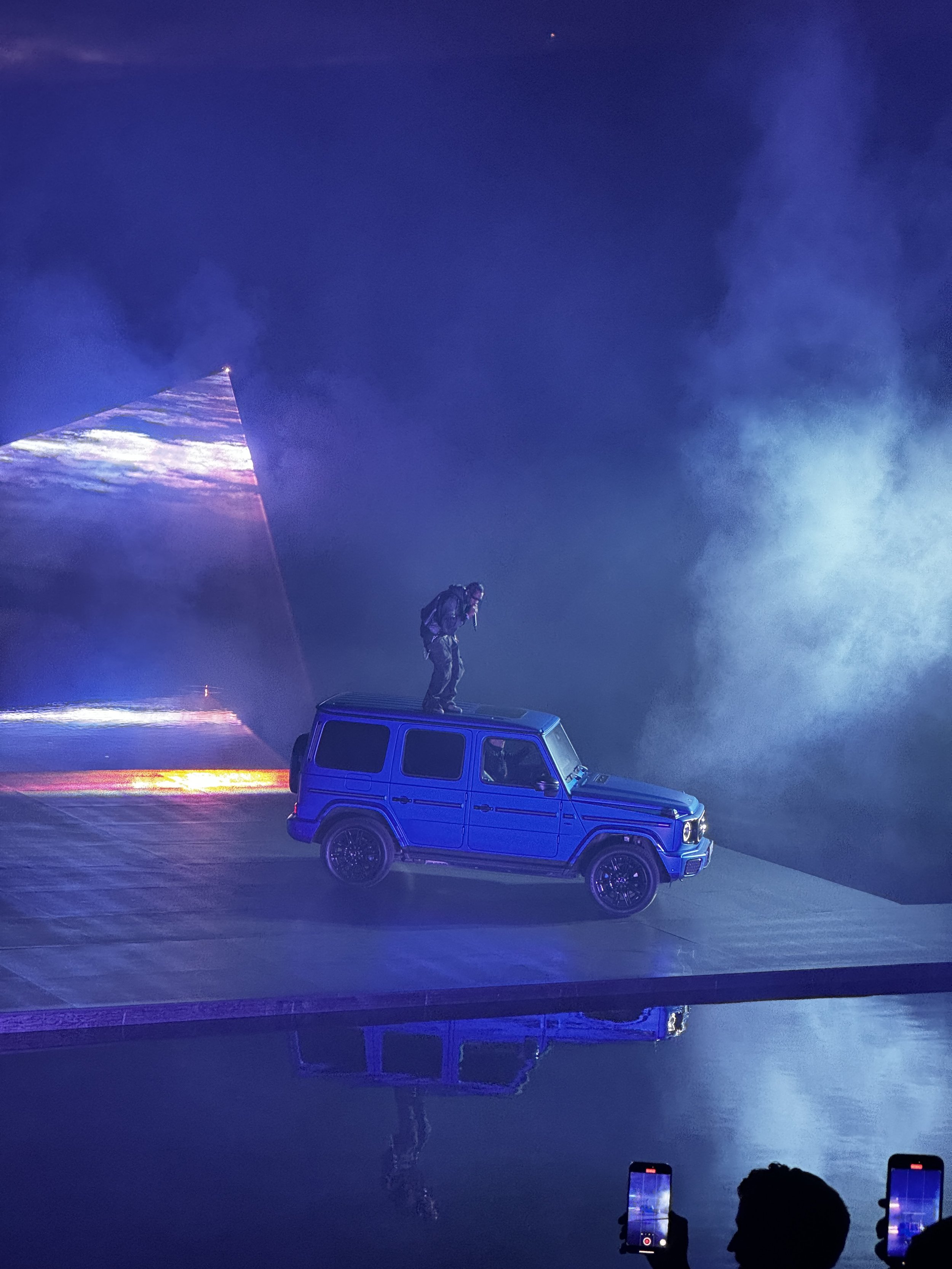The Electrified Mercedes-Benz G-Wagen Reaches for the Stars
Bettina Fetzer Vice President Communications & Marketing Mercedes‐Benz On The Making of a Moment
Bettina Fetzer, Vice President of Marketing and Communications for Mercedes-Benz, photo: Mercedes-Benz.
Smoky mist and lavender lights cast a haze over Franklin Canyon Park in Beverly Hills after dark on Tuesday night. Suddenly, headlights came into focus as the newest Mercedes-Benz G-Class — affectionately known as the G-Wagen —pulled up in stunning style. Heavy bass echoed off lush tree branches over a stage constructed on top of a reservoir. Out popped Travis Scott who leapt onto the roof of the SUV, where he continued to perform an eight-song set. For the newer track, “I Know,” he laid on his back, singing up into the stars. The carefully curated audience made up on Hollywood influencers — Tracee Ellis Ross, Ciara, Saweetie, and Bradley Cooper among them, several bodyguards, and a smattering of the media milled on a platforms as a sea of iphones documented it all. Near the bar, Kendall Jenner dressed in a dark moss green suit paired with square-toed brown patent boots, posed with her G500 cabriolet, and stuck out her tongue for the camera with a smile. It was a well-crafted push to usher in the arrival of the electric Mercedes-Benz G580, a splashy over-the-top moment for Mercedes-Benz as the brand showed it 45-year old iconic star-powered G-Wagen re-imagined as a California electric dream. The G580 boast all kinds of nifty accoutrements such as the wide-angle G-Turn, the hard-to-slam doors, and a simulated engine growl to appease enthusiasts. It will have range of just under 300 miles and a price tag that starts at about $150,000. The waitlist for the G580 is already ridiculously long.
Bettina Fetzer, Vice President communications and Marketing for Mercedes-Benz is responsible for the architecture of the campaign, and its parallel launch in China, ahead of the 2024 Beijing Motor Show. We spoke to Fetzer about the significance of the all-electric G-Wagen that Mercedes execs regularly refer to as the Birken bag of their brand.
TW: How do you think about change in the auto industry?
BF: The disruption that the automotive industry has gone through in the last couple of years has been more or less unprecedented, right? Everybody was kind of aligned that there's only one way to go and it's electric. The question was just how far would it go and how fast would it progress? The whole industry has probably been a bit too positive (about) how fast people were going to change. The strategy to go full electric has been the right one, but the pace is just a little bit slower.
“We have appeal to minds and hearts equally. ”
TW: It seems like being a marketer in this time is especially interesting because you're really an educator, right? How do you think differently than you would have a decade ago?
BF: As marketers, you always have two main roles. You have to appeal to the head and the heart of people. In a time of huge change, you sometimes feel that you have to be more on the rational side, explaining facts and figures and the technology and the benefits of what you're doing. We always say, getting people into the car driving is believing. But you should not ever forget the emotional part, especially in the luxury sector. A lot of decisions are purely emotional. If you make a change that is somewhat a conscious choice for sustainability, people still have to want it. Our main route is to make a product or a brand relevant and desirable. And it's only if those two facts are aligned, this is when the consumer is hooked, right? We have appeal to minds and hearts equally.
Kendall Jenner at the launch of the Mercedes-Benz G-Class. Photo courtesy of Mercedes-Benz.
TW Mercedes-Benz has always been a product-oriented brand, but the interesting part about the EV conversion is that it’s a lifestyle change too. How do you think about changing, reaching new folks that are maybe not even in the brand at all?
BF To be fair, the G-Wagen will be the easiest one (to electrify). From personal experience, there's been quite a lot of people who always wanted to have a G-Wagen, but they didn't drive it because they wanted to have a good, sustainable footprint. We didn't have anything to offer them. The waiting list is long. It will probably be more challenging to transfer the existing customers into the EV, because people who drive the G-Wagen normally love the sound of the vehicle, the way you feel it when you drive. You want to hear it. One of the things that is written for the G is that it can go anywhere and everywhere. So, we have invested quite a lot of communication effort into convincing the traditional customers that they're driving a real G. It creates a huge opportunity if people see if Mercedes-Benz can turn a G-Class into electric, it can do it for any other car. So the halo spreads, right?
TW It seems like there's long-term thinking here, trying different things, working in digital but in unique ways from the past.
Travis Scott performs with the Mercedes-Benz G580. Photo: Tamara Warren
BF I spend a lot of time on strategy and planning with my team. Are we there when the consumer is actually in market? We saw huge changes to the luxury industry over the last couple of years. The question is, how fast can you act on them? If you look at some of the things that are happening with digitization, ten years ago we would look at magazines whereas now you're just over flooded with information. You’re constantly bombarded with new brands, with new products, and there's so much noise happening. Every now and then we need to create an iconic moment that just cuts through the noise.
The second thing that we're watching is that the consumers are changing. They’re becoming younger. Gen Z is growing into our target group that has a different set of values – seventy percent of them say that they want a brand that speaks to them that is aligned with their values.
The third part is that the way your products and brands are judged is changing. Brands are made on the street. It's street culture. It's a handful of selected people, the cultural pioneers or the key opinion leaders that are actually the ones who have an audience that speak to your target audience. Those are the people you want to get for your brand. Those are the ones that need to be constantly inspired. You do a multi-angle orchestration of communications that is an integral part of 12 months of planning. Then you have that big iconic moment where you cut through the noise. You need to have a very organic way of telling that story further.
Kendall Jenner actually put one of her cars on display for us and said, I'm so proud of this convertible. There will be something happening on her channel. Then you have other talents that you might use for the campaign later on, so it’s very consistent storytelling. I keep referring to my job that though it was fun ten years ago, it's just getting so much more creative.




